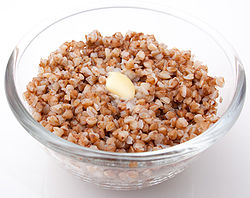
This is a list of buckwheat dishes, consisting of dishes that use buckwheat as a main ingredient. Buckwheat is a plant cultivated for its grain-like seeds and as a cover crop. A related and more bitter species, Fagopyrum tataricum , a domesticated food plant common in Asia, but not as common in Europe or North America, is also referred to as buckwheat.





